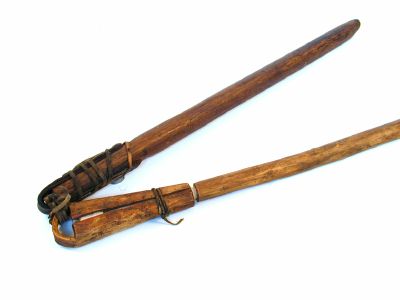Okinawa has grown barley, rice, and soybeans for probably hundreds of years. One reference to rice fields and paddies sets the beginnings of such agriculture around pre-1200 (Mid Shell-Mound Era). The northern part of Okinawa is mountainous but there are many flat open areas where rice paddies exist, and mountainous terraces are used to grow other crops.
https://storage.googleapis.com/hippostc ... 66-800.jpg
The above photo shows the gentle type of "mountainous" terrain of northern Okinawa. Nagahama, next door to Zakimi in Yomitan, is on such a "mountain" (actually a low gentle rise common to Okinawa, sloping upward to probably a few hundred meters above sea level).
Even Ie Jima, which many think of as just being a rock in the ocean, has fields and rich soil, and is known for barley, rice, tobacco (relatively recently), soybeans, and more.
Sumako, whose family is from Nago and northern areas, tells me that wheat and corn are more recent additions to Okinawa's crop harvest, but this still illustrates that northern Okinawan soil is rich and soft enough to grow almost anything.
https://visitokinawajapan.com/travel-in ... -ieisland/
When we think of “mountainous area” we usually think Himalayas, Rocky Mountains, the more severe mountains in areas like Equador, central or southern Europe, or continental Asia, and such. The “mountains” of Okinawa are mostly gentle, more like slopes or hills. There are a few real “mountains” that offer climbing challenges, but not many. Most are just gentle upward slopes. The soil is not mostly just rock.
Since the 1960's or so, wheat especially figures into northern Okinawan cuisine. Wheat flour is used almost exclusively for making Okinawan noodles, which are a staple in the Okinawan diet. Soybeans of course are used to make tofu, the protein-rich soybean curd that is used almost daily in all kinds of cooking. And rice, well...
Kanbun would definitely have seen and possibly used flails to separate barley or rice from the chaff. A working farm family wouldn’t do little or nothing most of the year while waiting on the radish harvest, they would likely help their neighbors and friends who grew other crops, or worked in their own fields with grain crops and other root veggies (radishes, potatoes, various squashes and melons, fruits, berries, tea fields, etc.). Farming families on Okinawa help each other, and receive help with their own crops later, too.
In the Izumi vicinity (Motobu) there are not just mountains, rocks, and harsh land that is hard to grow things on, a severe living eked out of rocky soil that yields little... There are rich flat lands and wide fertile fields for growing grains and root vegetables, and paddies are carved onto slopes and gentler mountainsides. As farmers, I believe the Uechi Family did rather well on their own lands (not making much money, but at least growing crops). Apparently they even grew tobacco (at least since after WW2). Kanbun would likely have seen and worked several kinds of crops and worked with many kinds of farming implements including flails (which likely became nunchaku), kama (blades for cutting down sugar cane and other stalks), and bo (which just means "stick" and was used to carry bundles of stalks, water jugs, etc.) not just spending his youth pulling up radishes...
Working on a farm with all kinds of crops coming into harvest at various times of the year, and helping each other out in a farming community, a farm boy could easily grow to be a very strong young man.
By the way, Kanbun Sensei taught nunchaku technique, as well as sai, bo, and possibly other weapons. This is being researched further. Kanejana Seishin Sensei showed us Kanbun Sensei's nunchaku technique, and while it appears to be extremely simple, it is not easy at all and delivers quite direct and dangerous strikes! I have been practicing it for a few years.
Regards and good health,
Seizan

